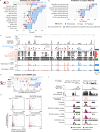ChromatinHD connects single-cell DNA accessibility and conformation to gene expression through scale-adaptive machine learning
- PMID: 39747019
- PMCID: PMC11697365
- DOI: 10.1038/s41467-024-55447-9
ChromatinHD connects single-cell DNA accessibility and conformation to gene expression through scale-adaptive machine learning
Abstract
Gene regulation is inherently multiscale, but scale-adaptive machine learning methods that fully exploit this property in single-nucleus accessibility data are still lacking. Here, we develop ChromatinHD, a pair of scale-adaptive models that uses the raw accessibility data, without peak-calling or windows, to link regions to gene expression and determine differentially accessible chromatin. We show how ChromatinHD consistently outperforms existing peak and window-based approaches and find that this is due to a large number of uniquely captured, functional accessibility changes within and outside of putative cis-regulatory regions. Furthermore, ChromatinHD can delineate collaborating regulatory regions, including their preferential genomic conformations, that drive gene expression. Finally, our models also use changes in ATAC-seq fragment lengths to identify dense binding of transcription factors, a feature not captured by footprinting methods. Altogether, ChromatinHD, available at https://chromatinhd.org , is a suite of computational tools that enables a data-driven understanding of chromatin accessibility at various scales and how it relates to gene expression.
© 2024. The Author(s).
Conflict of interest statement
Competing interests: The authors declare no competing interests.
Figures






Similar articles
-
Quantitative analysis of cis-regulatory elements in transcription with KAS-ATAC-seq.Nat Commun. 2024 Aug 10;15(1):6852. doi: 10.1038/s41467-024-50680-8. Nat Commun. 2024. PMID: 39127768 Free PMC article.
-
scATAC-seq generates more accurate and complete regulatory maps than bulk ATAC-seq.Sci Rep. 2025 Jan 29;15(1):3665. doi: 10.1038/s41598-025-87351-7. Sci Rep. 2025. PMID: 39881144 Free PMC article.
-
Comprehensive single-cell chromatin and transcriptomic profiling of peripheral immune cells in nonsegmental vitiligo.Br J Dermatol. 2025 Jun 20;193(1):115-124. doi: 10.1093/bjd/ljaf041. Br J Dermatol. 2025. PMID: 39888372
-
The Lived Experience of Autistic Adults in Employment: A Systematic Search and Synthesis.Autism Adulthood. 2024 Dec 2;6(4):495-509. doi: 10.1089/aut.2022.0114. eCollection 2024 Dec. Autism Adulthood. 2024. PMID: 40018061 Review.
-
Fabricating mice and dementia: opening up relations in multi-species research.In: Jenkins N, Jack-Waugh A, Ritchie L, editors. Multi-Species Dementia Studies. Bristol (UK): Bristol University Press; 2025 Feb 25. Chapter 2. In: Jenkins N, Jack-Waugh A, Ritchie L, editors. Multi-Species Dementia Studies. Bristol (UK): Bristol University Press; 2025 Feb 25. Chapter 2. PMID: 40690569 Free Books & Documents. Review.
References
-
- Wu, C., Wong, Y. C. & Elgin, S. C. The chromatin structure of specific genes: II. Disruption of chromatin structure during gene activity. Cell16, 807–814 (1979). - PubMed
-
- Levy, A. & Noll, M. Chromatin fine structure of active and repressed genes. Nature289, 198–203 (1981). - PubMed
-
- Tedesco, M. et al. Chromatin Velocity reveals epigenetic dynamics by single-cell profiling of heterochromatin and euchromatin. Nat. Biotechnol.40, 235–244 (2022). - PubMed
Publication types
MeSH terms
Substances
Associated data
- Actions
- Actions
LinkOut - more resources
Full Text Sources

